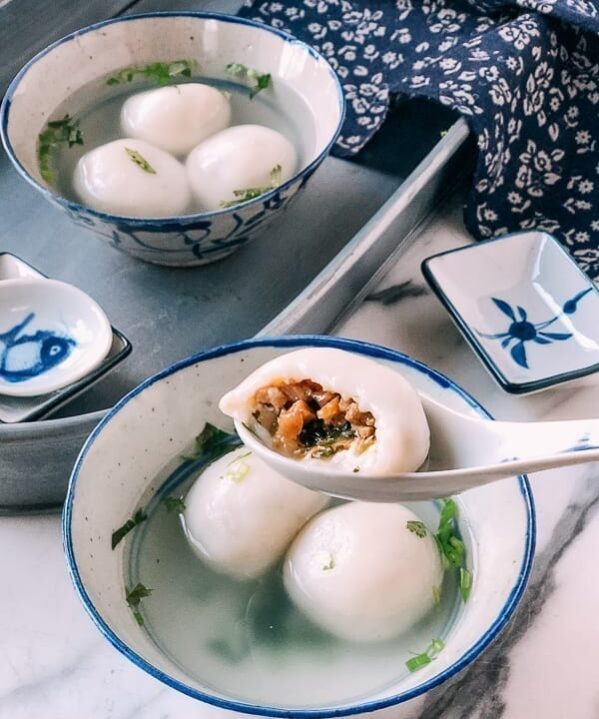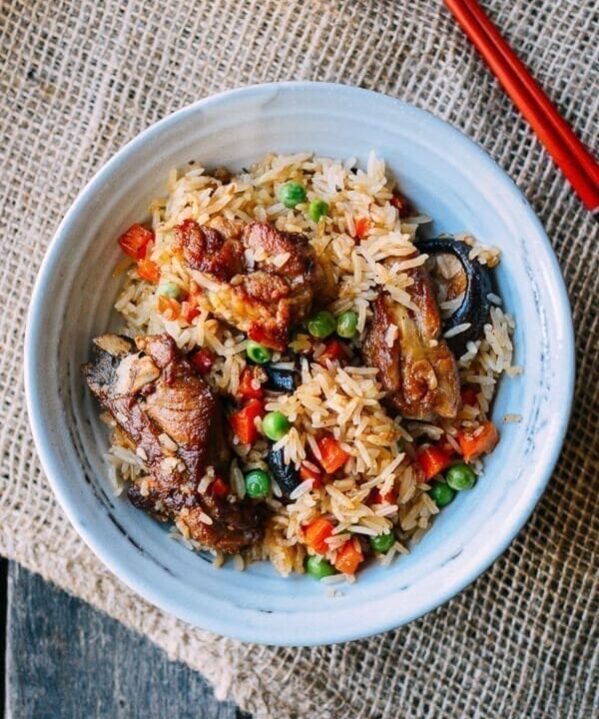An important and auspicious recipe to make during the Lantern Festival is Tang Yuan (汤圆), or Yuan Xiao (元宵). It’s a food that symbolizes harmony and reunion.
Note: This recipe was originally published in February 2016. It has since been updated with metric measurements.
What Is the Lantern Festival?
The Lantern Festival is the 15th day of Chinese New Year, which falls on Friday, February 26th this year. It’s also the last day of the Chinese New Year celebration. Hundreds of well-lit lanterns of all sizes, shapes, and colors fill houses, streets and alleyways. Performers on stilts, dragon dancers, street entertainers, and food vendors gather in a celebratory pandemonium that’s an expression of hope for a healthy and prosperous New Year.
We experienced this festive atmosphere firsthand when visiting a Chengdu Temple fair while living in China for a few years. It was a memorable experience, and we were glad that we braved the infamous Chinese New Year travel migrations and overcrowded train stations to get there!
The Process of Making Tang Yuan
In the old days, making tang yuan was a huge project that required plenty of hard labor. First, you needed to locate a heavy stone grinder, usually by borrowing one from another family. Then you’d have to soak the sweet glutinous rice overnight.
The next day, you would hand-grind the sweet rice along with water, ONE SPOONFUL AT A TIME by feeding it through the small hole on top of the grinder. The watery liquid was collected, then transferred to a thick cotton cloth sack.
The sack was hung or weighed down by the stone grinder overnight to strain all the water out. What was left in the morning was the dough. Two days in…only halfway done.
So it’s on to the tang yuan filling: roast the sesame seeds, crush them using a rolling pin, and add in sugar and fat. Yep. Pork suet was used in traditional sweet black sesame balls.
With cold temperatures this time of year and no indoor heating, kneading solid fat into a paste takes a long time, plus some strong muscles.
I don’t want to scare you out of making these tang yuan, but I do want to point out that with a food processor and store-bought sweet rice flour, this recipe is easy-peasy compared to the way it was made in the past!
Additional Recipe Notes:
In order to make this the traditional way, I ran around looking for pork suet, but, alas, we live in a different time. Our local supermarket sells beef suet, and I tried it out.
Like a good recipe developer, I’ve made three different kinds of fillings: one with beef suet, one with butter, and one with coconut oil. The beef suet lost the competition, because it’s too messy to work with.
Interestingly, though, the beef suet did not make the filling taste meaty at all. Coconut oil is a good option for vegans, but it does have a strong coconut flavor. So, butter was the winner. Bonus: it’s widely available.
Some important tips:
- You must use caster sugar to achieve the right filling texture!
- If you use decide to use coconut oil, the filling will harden when stored in the refrigerator, but it will soften back up at room temperature.
- Use roasted black sesame seeds. To roast your own sesame seeds, place a clean, dry wok over medium low heat, add the sesame seeds, and stir continuously for 7-8 minutes, until fragrant. Allow to cool completely.
- The tang yuan dough recipe makes about one dozen sesame balls (four servings). The filling recipe makes about four dozen. You can store leftover filling in the refrigerator––it will be good for a month or two, and you can make more dough whenever you want to enjoy them fresh.
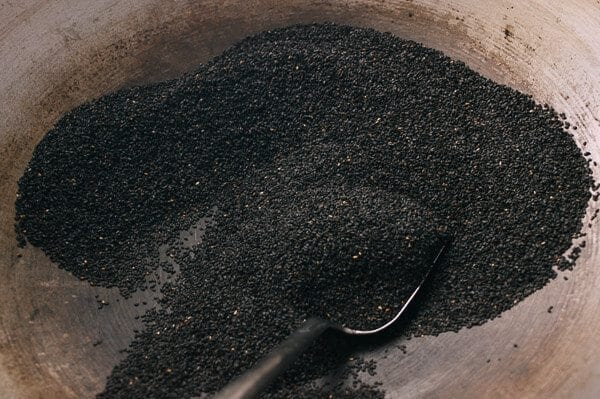
Tang Yuan Recipe Instructions
In a food processor or blender, finely grind the roasted black sesame seeds. Add the caster sugar (AKA superfine sugar) and use a spatula to mix together in the food processor a bit. Then add the butter and pulse for 10 seconds at a time to combine.
Scoop everything out into a bowl and put in the refrigerator for about 30 minutes. The purpose of this cooling process is to harden the mixture slightly for easy handling later.
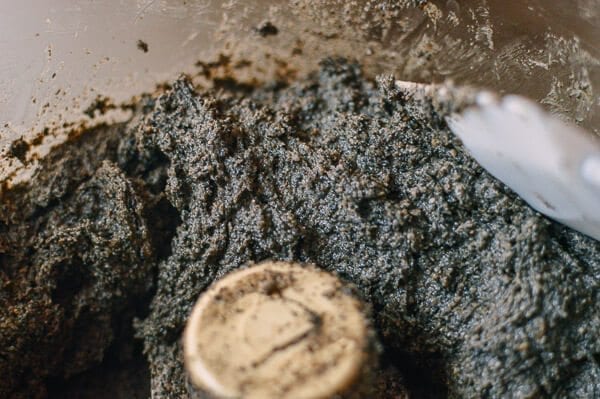
While the filling is cooling, make the dough. Put the sweet rice flour into a mixing bowl. Slowly add in the warm water, while stirring to form a dough. The dough can’t be too wet, or it will not hold its shape. Cover with a damp towel.
Now boil some water in a small pot, take out a small piece of the dough, about 1” in diameter. Add it to the boiling water and cook the piece of dough until it floats. Scoop it out and add it to the rest of the dough. Mix the two parts together until the dough is soft and smooth.
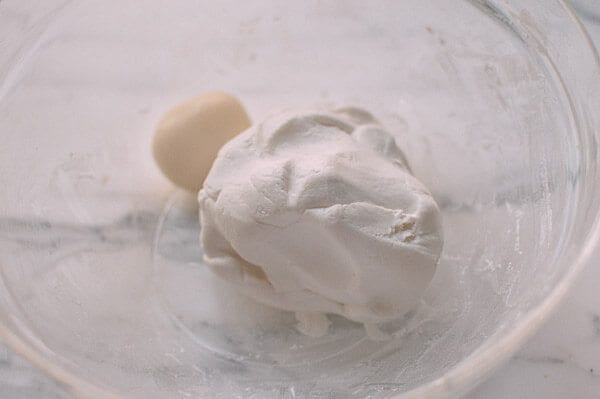
Divide the dough into 12 equal pieces (about 18 grams each, if you want to be really exacting), and roll them into balls. Keep the dough and dough balls covered with a damp paper towel while assembling.
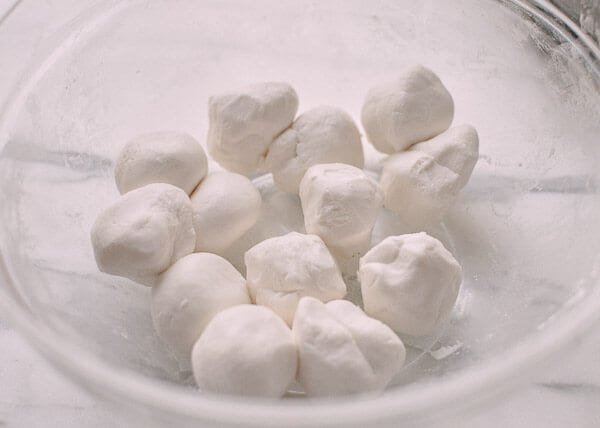
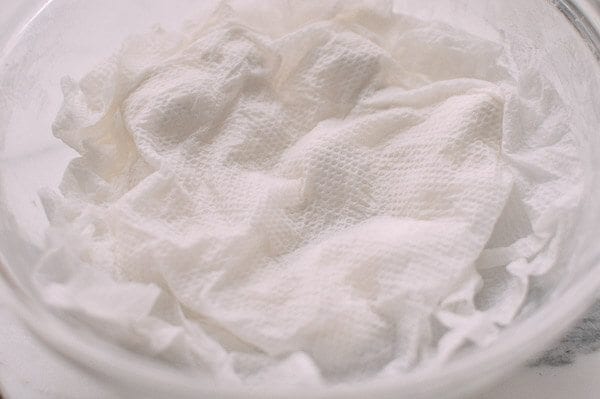
Take out the filling after cooling for 30 minutes. It should be slightly hard, but still workable. Roll the tang yuan filling into small marble-sized balls, about 4 to 5 grams each.
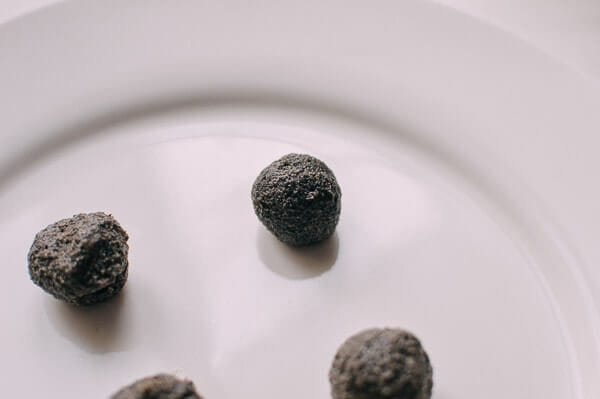
Then take each dough ball and flatten into a circle about 2 inches in diameter. Add the filling to the center, and close the dough over the filling.
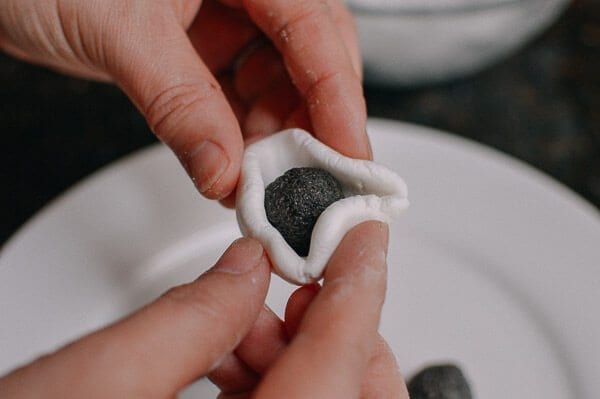
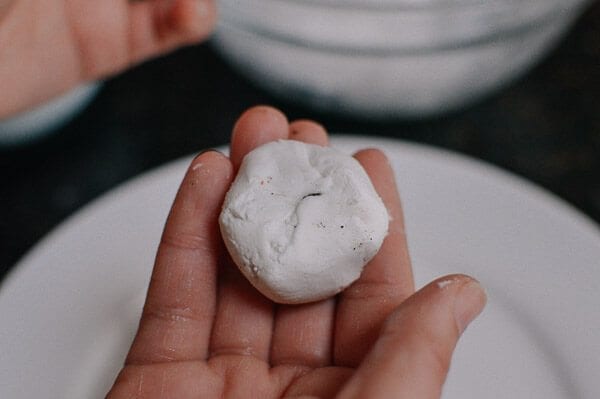
Roll the ball around in your hands until it’s smooth and round. Repeat until you’ve made all the sesame balls. Cover the remaining filling and return to the refrigerator for later!
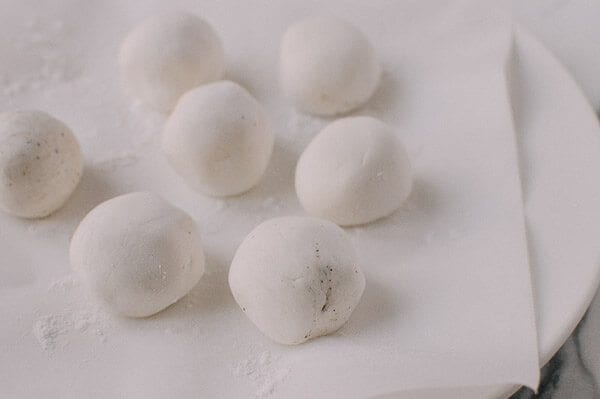
While you are assembling, bring a medium pot of water to a boil. Add the sesame balls and stir immediately to prevent them from sticking. Adding the sesame balls will cool down the water temperature significantly, so once the water comes back up to a boil, add a 1/2 cup of water to the pot.

Repeat this step two more times. This cooking process will allow enough time for the sugar and butter to melt nicely into a smooth filling. Serve the sesame balls in a bit of the hot cooking water in nice porcelain bowls and soup spoons!
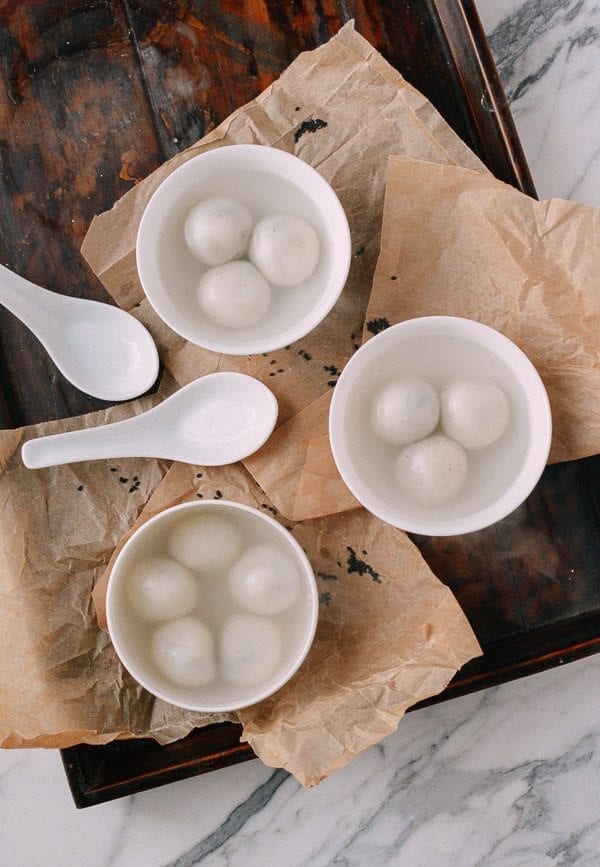
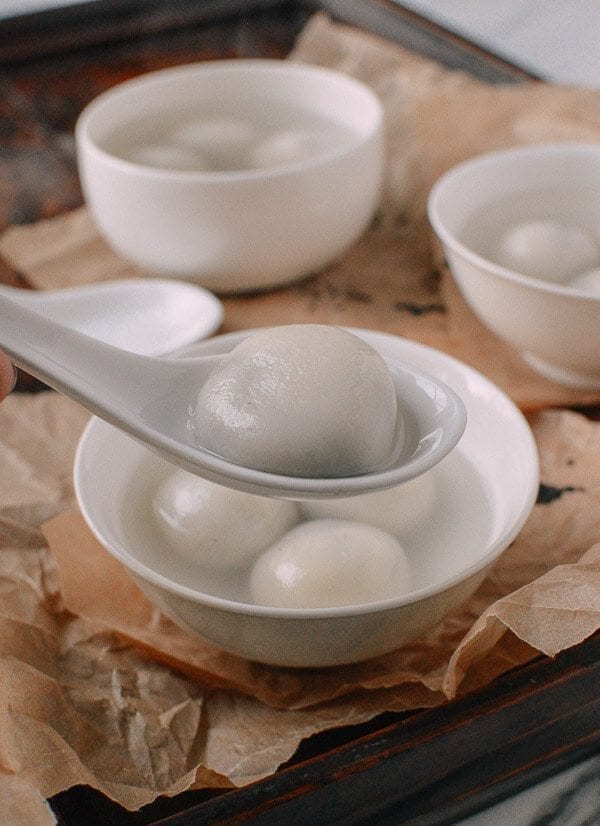
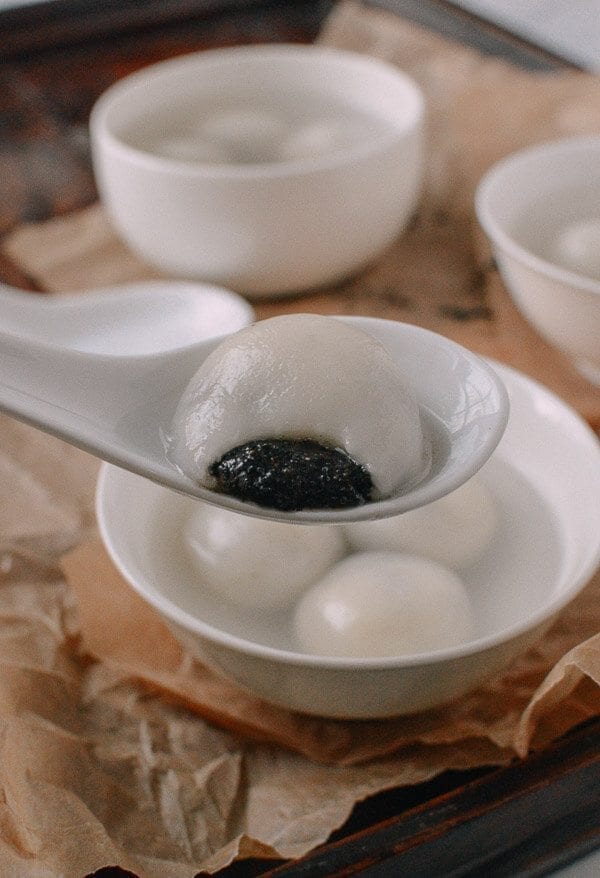
Tang Yuan (Sweet Rice Balls with Black Sesame Filling)
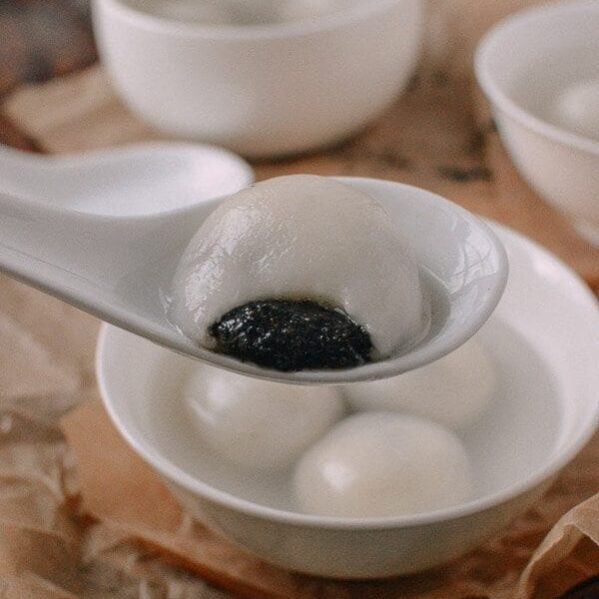
Ingredients
- 2 oz. roasted black sesame seeds
- 3 oz. caster sugar (about 1/3 cup)
- 6 tablespoons butter (softened, not melted!)
- 1 cup sweet rice flour (also known as glutinous rice flour, plus more for dusting)
- 1/2 cup warm water
Instructions
- In a food processor or blender, finely grind the sesame seeds. Add the caster sugar and use a spatula to mix together in the food processor a bit. Then add the butter and pulse for 10 seconds at a time until the mixture is well combined. Scoop everything out into a bowl and put in the refrigerator for about 30 minutes. The purpose of this cooling process is to harden the mixture slightly for easy handling later.
- While the filling is cooling, make the dough. Put the sweet rice flour into a mixing bowl. Slowly add in the warm water, while stirring to form a dough. The dough can’t be too wet, or it will not hold its shape. Cover with a damp towel.
- Now boil some water in a small pot, take out a small piece of the dough, about 1” in diameter. Add it to the boiling water and cook the piece of dough until it floats. Scoop it out and add it to the rest of the dough. Mix the two parts together until the dough is soft and smooth. Divide the dough into 12 equal pieces (about 18 grams each, if you want to be really exacting), and roll them into balls. Keep the dough and dough balls covered with a damp paper towel while assembling.
- Take out the filling after it’s cooled for 30 minutes. It should be slightly hard, but still workable. Roll the filling into small marble-sized balls, about 4 to 5 grams each. Then take each dough ball and flatten into a circle about 2 inches in diameter. Add the filling to the center, and close the dough over the filling. Roll the ball around in your hands until it’s smooth and round. Repeat until all the sesame balls are made. Cover the remaining filling and return to the refrigerator for later!
- While you are assembling, bring a medium pot of water to a boil. Add the sesame balls and stir immediately to prevent them from sticking. Adding the sesame balls will cool down the water temperature significantly, so once the water comes back up to a boil, add a 1/2 cup of water to the pot. Repeat this step two more times. This cooking process will allow enough time for the sugar and butter to melt nicely into a smooth filling. Serve the sesame balls in a bit of the hot cooking water!

